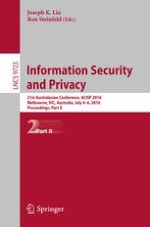2016 | OriginalPaper | Buchkapitel
Generalized Hardness Assumption for Self-bilinear Map with Auxiliary Information
verfasst von : Takashi Yamakawa, Goichiro Hanaoka, Noboru Kunihiro
Erschienen in: Information Security and Privacy
Aktivieren Sie unsere intelligente Suche, um passende Fachinhalte oder Patente zu finden.
Wählen Sie Textabschnitte aus um mit Künstlicher Intelligenz passenden Patente zu finden. powered by
Markieren Sie Textabschnitte, um KI-gestützt weitere passende Inhalte zu finden. powered by
